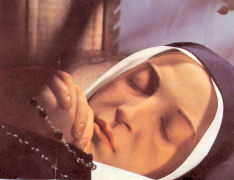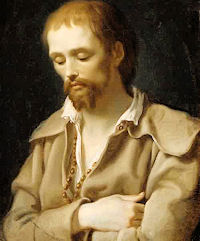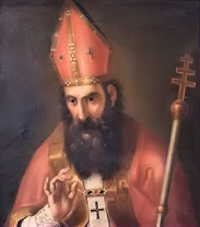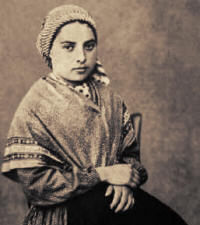Easter: April 16th
Tuesday of the Third Week of Easter
Other Commemorations: St. Marie Bernard Soubirous (Bernadette), Virgin (RM); St. Benedict Joseph Labre (RM)
» Enjoy our Liturgical Seasons series of e-books!
The Roman Martyrology's commemorations today include:
- St. Bernadette Soubirous (1844-1879). Bernadette, the oldest of six children, was born in Lourdes, France, in 1844. At the age of 14, between 11 February 1858 and 16 July 1858, Bernadette had 18 visions of the Immaculate Conception in a local grotto near the bank of the River Gave, near Lourdes. During the visions, Mary requested prayer and penitence, asked for the construction of a new church, and led Bernadette to a freshwater spring believed to have miraculous healing powers. Despite strong doubt and even opposition from political and church officials, Bernadette's faith in what she had witnessed remained steadfast and humble. Saint Bernadette longed to become a Carmelite nun, but ill health prevented her from doing so. In 1866, she retreated from the public eye to the convent Notre Dame at Nevers where she remained until her death at the age of 35.
- St. Benedict Joseph Labre (1748-1783). Benedict who was called the "Beggar of Rome" and was a pilgrim recluse. He was born in Amettes, France, on March 25, 1748, the eldest of eighteen children. He was devoted to the Blessed Sacrament and attended Forty Hours devotion in the city. He died in Rome on April 16.
- St. Evodius (c. 69) was one of the seventy-two disciples Christ, and Catholic tradition has always held that he was the first bishop of Antioch after St. Peter. As bishop of Antioch, he was the first to coin the word “Christian” to refer to the disciples of Jesus. He probably died between the years 64-67, when he was then succeeded by St. Ignatius of Antioch.
Meditation for Tuesday of the Third Week of Easter
Patience in suffering
1. "Who when He was reviled, did not revile; when He suffered, He threatened not" (Epistle). Patience in suffering and the disposition to forgive the persecutor, have always been the true mark of the great servants of Christ. St. Stephen, the first great martyr of the Church imitated Christ in begging for forgiveness for his murderers. He stood staunchly for the truth, even unto death as Christ had done; and although he knew that his assertion that he saw "the heavens opened, and the Son of man standing at the right hand of God" would be used as an excuse for his murder, he would not deny the truth. Although he knew that he was being unjustly put to death, like his divine Master he could exclaim, "Lord, do not lay this sin against them" (Acts 7:60).
This disposition to forgive did not die with St. Stephen, but has continued to be one of the most characteristic virtues of the saint. We read in the life of St. Benedict as related in the Dialogues of St. Gregory, that he was continuously and severely persecuted by a delinquent priest who lived in the neighborhood of the monastery. Finally, in order to protect the virtue and the vocations of his disciples, St. Benedict decided to abandon the site of his monastery and move to another location. He and his monks had hardly left their monastery when word was brought that the persecutor had died suddenly. Contrary to the expectation of the messenger who brought the news, St. Benedict broke out in loud lamentations that his enemy had died suddenly and had not had an opportunity to repent. The saints see so much more clearly than we the relative unimportance of the hardships and injustices we suffer in this world, and the importance before all else of the sinner's being converted and repenting of his sins. How differently we act sometimes! How long and how persistently we harbor grudges in our hearts against those who have offended us. How difficult we find it to forgive freely and from our hearts. Yet we proclaim ourselves to be Christians and to practice all the Christian virtues. Do we forget that our Lord told us that if we expect our prayers to be heard, and our sacrifices to be pleasing in the sight of God, we must, if our brother has anything against us, leave our sacrifice at the altar, and go first and make peace with our brother? (Matt. 5:23.)
Nor is the disposition to forgive our enemies peculiar only to the saints and martyrs of the ancient Church; nor should we expect it to be, for the truth Christ preached was eternal, and if His disciples were commanded to forgive their enemies in His day, that command is still binding. When the Jesuit martyr, Father Pro was executed in Mexico some years ago, he was asked by his executioner if he had anything he wished to do, or anything he wished to say before the sentence was executed. Father Pro said that there was; he wished to be given an opportunity to pray for his executioners and to give them his blessing before he died. During the persecutions in Spain during the late civil war, one of the religious who was to be put to death by the communists was led to his death with his hands bound. When asked if he had any final request, he too, asked to be allowed to give his blessing to the members of the firing squad. It is said that the officer in charge of the guard untied his hands, and then swiftly struck off the hands of the priest with his sword, and said, "Now, Priest, give them your blessing." The Priest, blood streaming from his mangled wrists, raised his right arm and traced the sign of the cross over the heads of his murderers. This is the true sign of the authentic martyr, the characteristic mark of the true saint of the Church.
2. "Who did no sin, neither was guile found in His mouth. Who His own self bore our sins in His body upon the tree" (Epistle). The redemption of man as accomplished by Christ might have been accomplished in other ways, but none of them would have been as perfect as the way Christ chose. God might have forgiven man outright without requiring any satisfaction for sin. This would have been a splendid manifestation of the infinite mercy of God, but it would have ignored His infinite justice. God might have refused redemption and forgiveness altogether, and this would have been in complete conformity with His justice, but it would not have satisfied His infinite mercy. Perfect redemption required that both God's mercy and justice be satisfied. Man was in no position to help himself.
Any act of satisfaction on his part would only have been of limited and finite value, and would not have been adequate. An act of reparation offered by a divine person would have been adequate, but it would not have been authentic, since it would not have been offered by the offending party. The only possibility of a perfect redemption was for the divine person to become incarnate. Christ, since He was God, could perform acts of infinite value; since he was a human being, He could act in the name of the human race, and offer an act of reparation which would be both adequate and authentic.
3. "By whose stripes you are healed" (Epistle). As when he was speaking of the duty of subjection to superiors, so here St. Paul seems to be addressing himself to the servants and the slaves of his time. Slaves were often cruelly treated by their masters in ancient times, and stripes from the scourge were familiar to every slave. The slave understood that the stripes he received from his master were in payment for some offense he had committed. He would understand then, that the debt that was due to almighty God for sin, could be paid by the stripes Christ received. Since St. Paul points out to us that everything in Christ's life, and especially his conduct during His passion should be an example for the Christian, and that the Christian should follow in His footsteps, it might be well for us to remember that we can satisfy for our personal sins by bearing patiently the sufferings that come to us in this world. Much of the misfortune and the suffering we endure in this world is the result of our own foolishness and perversity. Nevertheless, we can offer all of the misfortunes that overtake us in reparation for our sins and for those of our friends and relatives. When sorrow and suffering trouble us we should offer our trials humbly to God thus making a feeble attempt to imitate Christ, "who suffered for us, leaving you an example that you should follow His steps" (Epistle).
—Benedict Baur, OSB, The Light of the World, Vol. 2
St. Bernadette
Marie Bernarde ('Bernadette') Soubirous was the eldest child of an impoverished miller. At the age of fourteen she was ailing and undersized, sensitive and of pleasant disposition but accounted backward and slow. Between 11 February and 16 July 1858, in a shallow cave on the bank of the river Gave, she had a series of remarkable experiences. On eighteen occasions she saw a very young and beautiful lady, who made various requests and communications to her, pointing out a forgotten spring of water and enjoining prayer and penitence. The lady eventually identified herself as the Virgin Mary, under the title of 'the Immaculate Conception'. Some of these happenings took place in the presence of many people, but no one besides Bernadette claimed to see or hear 'the Lady', and there was no disorder or emotional extravagance. After the appearances ceased, however, there was an epidemic of false visionaries and morbid religiosity in the district, which increased the reserved attitude of the church authorities towards Bernadette's experiences.

For some years she suffered greatly from the suspicious disbelief of some and the tactless enthusiasm and insensitive attentions of others; these trials she bore with impressive patience and dignity. In 1866 she was admitted to the convent of the Sisters of Charity at Nevers. Here she was more sheltered from trying publicity, but not from the 'stuffiness' of the convent superiors nor from the tightening grip of asthma. 'I am getting on with my job,' she would say. 'What is that?' someone asked. 'Being ill,' was the reply. Thus she lived out her self-effacing life, dying at the age of thirty-five. The events of 1858 resulted in Lourdes becoming one of the greatest pilgrim shrines in the history of Christendom. But St Bernadette took no part in these developments; nor was it for her visions that she was canonized, but for the humble simplicity and religious trustngness that characterized her whole life.
Patronage: against bodily ills; against illness; against poverty; against sickness; Lourdes, France; people ridiculed for their piety; poor people; shepherdesses; shepherds; sick people
Symbols and Representation: Young girl kneeling in front of a grotto, before the Blessed Virgin ("The Immaculate Conception") who wears a white dress, blue belt, and a rose on each foot. Bernadette is sometimes pictured after she received the habit.
Highlights and Things to Do:
- Read more about St. Bernadette:
- See Catholic Cuisine for some food ideas for this feast day.
- Her body is incorrupt, and now covered by wax. It is on display at Sanctuaire de Nevers Sainte Bernardette
St. Benedict Joseph Labre
 Saint Benedict Joseph Labre, born on March 26, 1748 in northern France, exemplifies a very particular kind of holiness found in both East and West. He was a wanderer who prayed ceaselessly, a pilgrim walking from one holy place to another, a fool for Christ.
Saint Benedict Joseph Labre, born on March 26, 1748 in northern France, exemplifies a very particular kind of holiness found in both East and West. He was a wanderer who prayed ceaselessly, a pilgrim walking from one holy place to another, a fool for Christ.
As a young man, Benedict Joseph made a number of unsuccessful attempts at monastic life. He tried his vocation with the Trappists, with the Cistercians, and with the Carthusians, but, in every instance, after a few months or a few weeks, he was rejected as being unsuitable. Benedict Joseph was endearing in his own way. He was a gentle young man, tortured by scruples of conscience, and sensitive. He was completely honest, humble, candid, and open. He was cheerful. But, for all of that, he was a misfit. There was an oddness about him. He was drawn irresistibly to monastic life and, at the same time, rejected from every monastery in which he tried his vocation.
When he was twenty-two years old, Benedict Joseph left the Abbey of Sept-Fons, still wearing his Cistercian novice's habit, with a rosary around his neck, and a knapsack on his back. His only possessions, apart from the clothes he wore, were his two precious rosaries, a New Testament, a Breviary for reciting the Divine Office, and The Imitation of Christ.
Walking all the way to Rome, begging as he went, he became a consecrated vagabond, a pilgrim vowed to ceaseless prayer. He walked from one shrine to another, visiting the Holy House of Loreto, Assisi, Naples, and Bari in Italy. He made his way to Einsiedeln in Switzerland, to Paray-le-Monial in France, and to Compostela in Spain. He lived on whatever people would give him, and readily shared what little he had. He observed silence, praying constantly. He was mocked, abused, and treated like a madman. Cruel children pelted him with garbage and stones.
After 1774, apart from an annual pilgrimage to the Madonna at the Holy House of Loreto, Benedict Joseph remained in the Eternal City. At night he would sleep in the Colosseum. During the day he would seek out those churches where the Forty Hours Devotion was being held, so as to be able to adore the Blessed Sacrament exposed. So striking was his love for the Blessed Sacrament that the Romans came to call him "the beggar of Perpetual Adoration." He was graced with a profound recollection in church. More than once he was observed in ecstasy, ravished into the love of God and shining with an unearthly light. It was on one of these occasions that the artist Antonio Cavallucci painted the beautiful portrait of Saint Benedict Joseph that allows us, even today, to see his handsome face illumined by union with God.
On April 16, 1783 Benedict Joseph collapsed on the steps of the Church of Santa Maria dei Monti. It was the Wednesday of Holy Week. He was carried to a neighbouring house where he received the last sacraments, and died. He was thirty-five years old. No sooner did news of his death reach the streets than a huge throng gathered crying, "È morto il santo!—The saint is dead!" Benedict Joseph was buried beneath the altar in a side chapel of Santa Maria dei Monti. I have gone there to pray, and knelt before the life-sized sculpture in marble that depicts him in the repose of a holy death.
Benedict Joseph Labre was dead but a few months when more than 136 miraculous healings were attributed to his intercession. Present in Rome at the time of his funeral was an American Protestant clergyman from Boston, The Reverend John Thayer. The experience of Benedict Joseph's holy death converted Thayer. He was received into the Catholic Church, ordained to the priesthood, and died in Limerick, Ireland in 1815.
—Excerpted from Vultus Christi
Patronage: against insanity; against mental illness; bachelors; beggars; hoboes; homeless people; mentally ill people; people rejected by religious orders; pilgrims; tramps; unmarried men
Symbols and Representation: beggar in a tri-cornered hat sharing his alms
Highlights and Things to Do:
- Read more about St. Benedict:
St. Evodius
 The first Bishop of Antioch after St. Peter. Eusebius mentions him thus in his "History": "And Evodius having been established the first [bishop] of the Antiochians, Ignatius flourished at this time" (III, 22). The time referred to is that of Clement of Rome and Trajan, of whom Eusebius has just spoken. Harnack has shown (after discarding an earlier theory of his own) Eusebius possessed a list of the bishops of Antioch which did not give their dates, and that he was obliged to synchronize them roughly with the popes. It seems certain that he took the three episcopal lists of Rome, Alexandria, and Antioch from the "Chronography" which Julius Africanus published in 221. The "Chronicle of Eusebius" is lost; but in Jerome's translation of it we find in three successive years the three entries that Peter, having founded the Church of Antioch, is sent to Rome, where he perseveres as bishop for 25 years; that Mark, the interpreter of Peter, preaches Christ in Egypt and Alexandria; and that Evodius is ordained first Bishop of Antioch.
The first Bishop of Antioch after St. Peter. Eusebius mentions him thus in his "History": "And Evodius having been established the first [bishop] of the Antiochians, Ignatius flourished at this time" (III, 22). The time referred to is that of Clement of Rome and Trajan, of whom Eusebius has just spoken. Harnack has shown (after discarding an earlier theory of his own) Eusebius possessed a list of the bishops of Antioch which did not give their dates, and that he was obliged to synchronize them roughly with the popes. It seems certain that he took the three episcopal lists of Rome, Alexandria, and Antioch from the "Chronography" which Julius Africanus published in 221. The "Chronicle of Eusebius" is lost; but in Jerome's translation of it we find in three successive years the three entries that Peter, having founded the Church of Antioch, is sent to Rome, where he perseveres as bishop for 25 years; that Mark, the interpreter of Peter, preaches Christ in Egypt and Alexandria; and that Evodius is ordained first Bishop of Antioch.
This last year is given as Claudius III by the Codex Freherianus, but by the fifth-century Bodleian Codex (not used in Schoene's edition) and the rest as Claudius IV (A.D. 44). The Armenian translation has Claudius II. We have no mention of Evodius earlier than that by Africanus; but the latter is confirmed by his contemporary, Origen, who calls Ignatius the second bishop after Peter (Hom. IV, in Luc., III, 938A). It is curious that the ordination of Evodius should not have been given in the "Chronography" in the same year as the founding of the Antiochian Church by Peter, and Hort supposed that the three entries must have belonged to a single year in Eusebius. But the evidence is not in favour of this simplification. The year of the accession of Ignatius, that is of the death of Evodius, was unknown to Eusebius, for he merely places it in the "Chronicle" together with the death of Peter and the accession of Linus at Rome (Nero 14-68), while in the "History" he mentions it at the beginning of Trajan's reign.
The fame of Ignatius has caused later writers, such as Athanasius and Chrysostom, to speak of him as though he were the immediate successor of the Apostles. Jerome (Illustrious Men 16) and Socrates (H.E. VI, 8) call him the "third" bishop after St. Peter, but this is only because they illogically include Peter among his own successors. Theodoret and Pseudo-Ignatius represent Ignatius as consecrated by Peter. The difficulty which thus arose about Evodius was solved in the Apostolic Constitutions by stating that Evodius was ordained by Peter and Ignatius by Paul. The Byzantine chronographer, John Malalas (X, 252), relates that as Peter went to Rome, and passed through the great city of Antioch, it happened that Evodus (sic), the bishop and patriarch, died, and Ignatius succeeded him, he attributes to Evodius the invention of the name Christian. Salmon does not seem to be justified in supposing that Malalas ascribes any of this information to Theophilus, the second century Bishop of Antioch. We may be sure that Evodius is an historical personage, and really the predecessor of St. Ignatius. But the dates of his ordination and death are quite uncertain. No early witness makes him a martyr.
The Greeks commemorate together "Evodus" and Onesiphorus (2 Timothy 1:16) as of the seventy disciples and as martyrs on 29 April, and also on 7 September. Evodius was unknown to the earlier Western martyrologies the Hieronymian, and those of Bede and Florus; but Ado introduced him into the so-called "Martyrologium Romanum parvum" (which he forged not long before 860) and into his own work, on 6 May. His source was Pseudo-Ignatius, whom he quotes in the "Libellus de fest. Apost.", prefixed to the martyrology proper. From him the notice came to Usuard and the rest, and to the present Roman Martyrology.
—Excerpted from the Catholic Encyclopedia
Highlights and Things to Do:
- Read more about Evodius:






